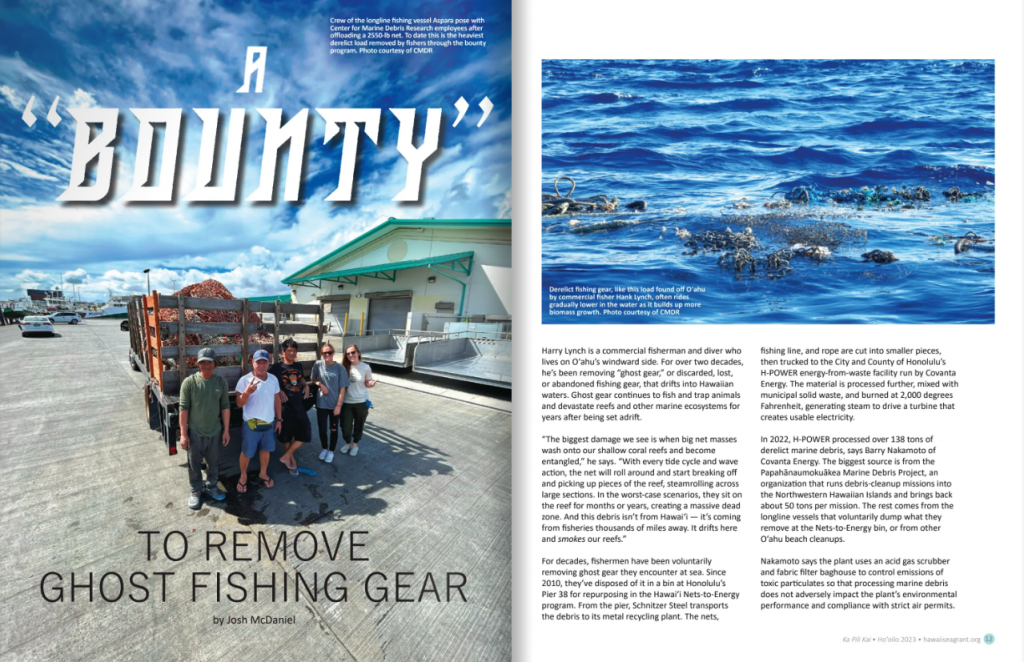Harry Lynch is a commercial fisherman and diver who lives on Oʻahu’s windward side. For over two decades, he’s been removing “ghost gear,” or discarded, lost, or abandoned fishing gear, that drifts into Hawaiian waters. Ghost gear continues to fish and trap animals and devastate reefs and other marine ecosystems for years after being set adrift.
“The biggest damage we see is when big net masses wash onto our shallow coral reefs and become entangled,” he says. “With every tide cycle and wave action, the net will roll around and start breaking off and picking up pieces of the reef, steamrolling across large sections. In the worst-case scenarios, they sit on the reef for months or years, creating a massive dead zone. And this debris isn’t from Hawai‘i — it’s coming from fisheries thousands of miles away. It drifts here and smokes our reefs.”
For decades, fishermen have been voluntarily removing ghost gear they encounter at sea. Since 2010, they’ve disposed of it in a bin at Honolulu’s Pier 38 for repurposing in the Hawai‘i Nets-to-Energy program. From the pier, Schnitzer Steel transports the debris to its metal recycling plant. The nets, fishing line, and rope are cut into smaller pieces, then trucked to the City and County of Honolulu’s H-POWER energy-from-waste facility run by Covanta Energy. The material is processed further, mixed with municipal solid waste, and burned at 2,000 degrees Fahrenheit, generating steam to drive a turbine that creates usable electricity.
In 2022, H-POWER processed over 138 tons of derelict marine debris, says Barry Nakamoto of Covanta Energy. The biggest source is from the Papahānaumokuākea Marine Debris Project, an organization that runs debris-cleanup missions into the Northwestern Hawaiian Islands and brings back about 50 tons per mission. The rest comes from the longline vessels that voluntarily dump what they remove at the Nets-to-Energy bin, or from other O‘ahu beach cleanups.
Nakamoto says the plant uses an acid gas scrubber and fabric filter baghouse to control emissions of toxic particulates so that processing marine debris does not adversely impact the plant’s environmental performance and compliance with strict air permits.
“H-POWER has state-of-the-art emissions controls that are continuously monitored to check that the combustion units and emissions control systems are functioning properly,” Nakamoto says.
For now, carbon emissions are not regulated the way toxic pollutants are, so these systems do not specifically address capturing greenhouse gases.
Building on the success of Nets-to-Energy, Hawai‘i Pacific University’s Center for Marine Debris Research has launched a program to pay fishermen like Harry Lynch a “bounty” of between $1 and $3 per dry pound to collect the derelict gear and bring it to shore.
Dr. Jennifer Lynch, co-director of the HPU Center for Marine Debris Research, says the program wants to reward fishermen who can remove this gear before it reaches Hawai‘i’s reefs and nearshore environments.
With funding from NOAA’s Marine Debris Program, HPU has partnered with the Hawai‘i Longline Association and the Department of Land and Natural Resources’ Division of Aquatic Resources to establish the bounty program.
Hawai‘i Longline Association Executive Director Eric Kingma says the derelict gear impedes navigation and causes huge financial costs for the 145-vessel Hawaiian longline fishing fleet.
“It’s a safety-at-sea issue,” Kingma says. “It’s not uncommon for a vessel of our fleet to encounter large net conglomerates [which can get] wrapped up in the prop.”
Kingma explains it is difficult for the fishermen to bring the material aboard at sea, from the hazards and time lost hauling it in, to the challenges of storing a large net mass on deck during a fishing trip.
“There’s a long history of our boats doing this for free, but a little compensation doesn’t hurt,” says Kingma.
Besides the economic benefits of removing the nets, fishermen emphasize that the project shows their commitment to environmental stewardship.
“Fishermen get a bad rap sometimes, especially commercial fishermen,” Kingma says. “But we also have an interest in a healthy and clean ocean. We’re all in it together. We’re volunteering and bringing this stuff back. There are positive stories in commercial fishing.”
Mark Manuel, coordinator for NOAA’s Marine Debris Program’s Pacific Islands Region, praises the commitment of NGOs, researchers, private industry, and fishermen to kick-start the bounty program.
“We have a great network and community of environmental stewards that are leading efforts to remove marine debris here in the state of Hawai‘i,” Manuel says. “By utilizing these vessels of opportunity to remove nets while they are fishing in areas prone to debris accumulation, we can increase the amount of nets recovered before they affect our nearshore and coastal resources.”
Nakamoto says participation in the Nets-to-Energy program is a “no-brainer” for Covanta, and he applauds HPU’s effort to increase collection of abandoned marine debris.
“Hawaiʻi’s waters must be protected, and by working with our partners and offering our sustainable services to rid the oceans of this old and abandoned material, we are helping preserve the ocean ecosystem for generations to come,” he says.
Browse Ka Pili Kai issues HERE


